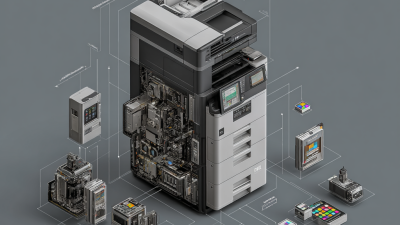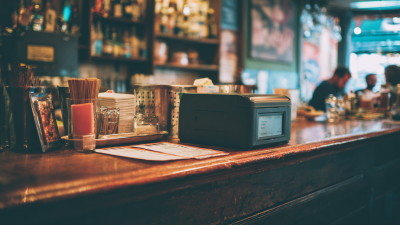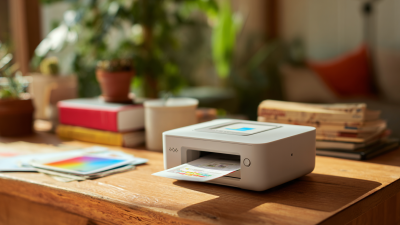In today’s fast-paced retail environment, enhancing customer experience is paramount, and one effective way to achieve this is through the use of Thermal Receipt Printers. These innovative devices not only streamline transaction processes but also play a crucial role in customer satisfaction. According to John Peters, a leading expert in retail technology, "Thermal Receipt Printers are revolutionizing the way businesses engage with their customers, turning a mere transaction into a seamless and enjoyable experience."
As retailers strive to maximize efficiency, the implementation of Thermal Receipt Printers can significantly reduce wait times at the point of sale, allowing customers to receive their receipts promptly and move on with their shopping experience. This improvement in service speed not only enhances customer satisfaction but also fosters customer loyalty. In addition, the crisp, clear print quality of thermal receipts ensures that important transaction details are easily readable, further contributing to a positive customer impression.

Moreover, the integration of Thermal Receipt Printers with modern POS systems allows for greater flexibility in terms of receipt customization and promotional offers, enabling retailers to engage customers in a more personalized manner. As the retail landscape continues to evolve, embracing the benefits of Thermal Receipt Printers will be essential for businesses aiming to stand out and provide exceptional customer service.
Thermal receipt printers have become an essential component in the retail sector, significantly enhancing the efficiency of transaction processes. These printers utilize heat to produce printouts, eliminating the need for ink or toner, thus reducing operational costs. According to a report by Grand View Research, the global thermal printer market is expected to reach approximately $5.46 billion by 2025, showcasing the growing reliance on this technology in retail environments. The speed of thermal printers, capable of producing receipts in a matter of seconds, not only reduces queue times but also boosts overall customer satisfaction.
In addition to speed and cost-effectiveness, thermal receipt printers contribute to improved customer experience through their reliability and high-quality printouts. The clarity of the printed text and graphics allows for better visibility of transaction details, enhancing customer trust and reducing disputes. A study from Nielsen indicated that 73% of consumers prefer retailers with efficient and hassle-free transaction processes, highlighting the significant impact that efficient printing solutions can have in retail. As retailers continue to prioritize customer experience, investing in thermal receipt printers proves to be a strategic move to streamline operations and foster customer loyalty.
In the fast-paced retail environment, print speed and quality play a crucial role in enhancing customer satisfaction. Thermal receipt printers offer significant advantages in these areas, ensuring that customers experience minimal wait times at checkout. With the ability to produce receipts rapidly, these printers cater to the high demands of retail transactions, allowing for a smoother flow of customers through the point of sale. The expedited service not only reduces frustration but also fosters a positive impression of the retail brand, encouraging repeat business.
Equally important is the quality of the printed receipts. Thermal printers are known for their sharp, clear text and graphics, which aid in customer understanding and retention of purchase details. High-quality receipts foster trust and confidence in the transaction, as customers can easily read and reference essential information. This combination of fast and clear printing not only enhances the immediate shopping experience but also contributes to long-term customer loyalty by portraying an image of efficiency and reliability in the retail environment.
The integration of thermal printers with digital payment systems is revolutionizing the retail experience. As consumers increasingly favor cashless transactions, having a reliable thermal receipt printer ensures that the entire checkout process is seamless and efficient. These printers quickly generate clear, high-quality receipts that can enhance customer satisfaction. By reducing wait times and minimizing potential errors, retailers can foster a smoother transaction atmosphere, encouraging customers to return.
Moreover, thermal printers can be programmed to work in sync with modern payment solutions, such as mobile wallets and contactless cards. This synergy streamlines the process, allowing customers to receive their receipts instantly on their smartphones or in printed form as they complete their purchases. Retailers benefit from this integration as well, as they can collect valuable data through receipts that can be used for marketing and inventory management. Overall, the collaboration between thermal receipt printers and digital payment systems elevates the customer experience by prioritizing convenience and efficient service.
In today's competitive retail landscape, customizable receipts offered by thermal receipt printers play a crucial role in enhancing customer experience and building brand loyalty. By allowing retailers to tailor receipt designs, colors, and messages, these printers help businesses create a distinctive brand identity that resonates with their customers. This personalization not only makes transactions more memorable but also provides a unique opportunity for brands to communicate special promotions, upcoming events, or loyalty programs directly on the receipt.
Moreover, customizable receipts serve as a powerful tool for customer engagement. Retailers can include QR codes or links that encourage customers to participate in surveys, follow the brand on social media, or visit their website for exclusive offers. This immediate connection fosters a sense of community and keeps customers informed about the evolving brand story. Ultimately, the ability to deliver personalized and engaging receipts not only enhances the shopping experience but also strengthens the emotional connection customers have with the brand, making them more likely to return for future purchases.
When selecting a thermal receipt printer for retail operations, understanding specific business needs is critical. According to a report by Smithers Pira, the global market for thermal printers is projected to grow at a CAGR of 6% from 2021 to 2026, indicating a rising demand among retailers for efficient printing solutions. Retailers should consider factors such as print speed, connectivity options, and durability. A printer with a high print speed—typically 200mm per second—can significantly reduce customer wait times, enhancing the overall shopping experience.
Additionally, connectivity plays a key role in integrating thermal printers with existing point-of-sale systems. Retailers should opt for printers that support multiple connectivity options, including Bluetooth, USB, and Wi-Fi. A study by MarketsandMarkets suggests that 52% of retailers prioritize seamless integration in their technology acquisition processes. Furthermore, durability is paramount; thermal printers designed to withstand the rigors of a retail environment can lower long-term costs by reducing maintenance and replacement needs. By focusing on these considerations, retailers can choose the right thermal printer that not only meets their operational requirements but also improves customer satisfaction.
| Feature | Benefit | Considerations | Recommended Usage |
|---|---|---|---|
| Speed | Faster transaction times lead to increased customer satisfaction | Assess typical transaction volume | High-traffic retail environments |
| Print Quality | Clear, legible receipts enhance customer trust | Check resolution specifications | Any retail setting where receipt clarity is important |
| Connectivity Options | Flexible integration with POS systems | Evaluate existing POS infrastructure | Multi-channel retail operations |
| Durability | Long-lasting printers reduce replacement costs | Consider warranty and service options | High-volume environments |
| Size & Design | Compact designs save counter space | Analyze workspace constraints | Small retail spaces |






